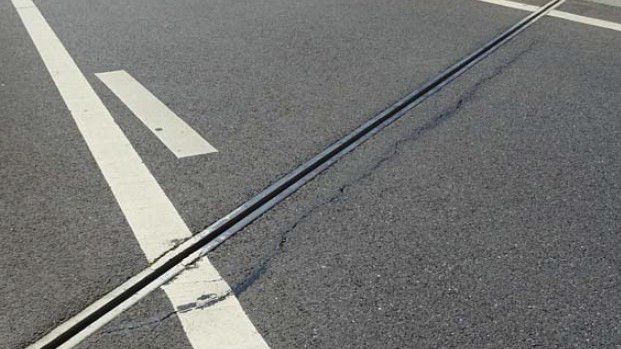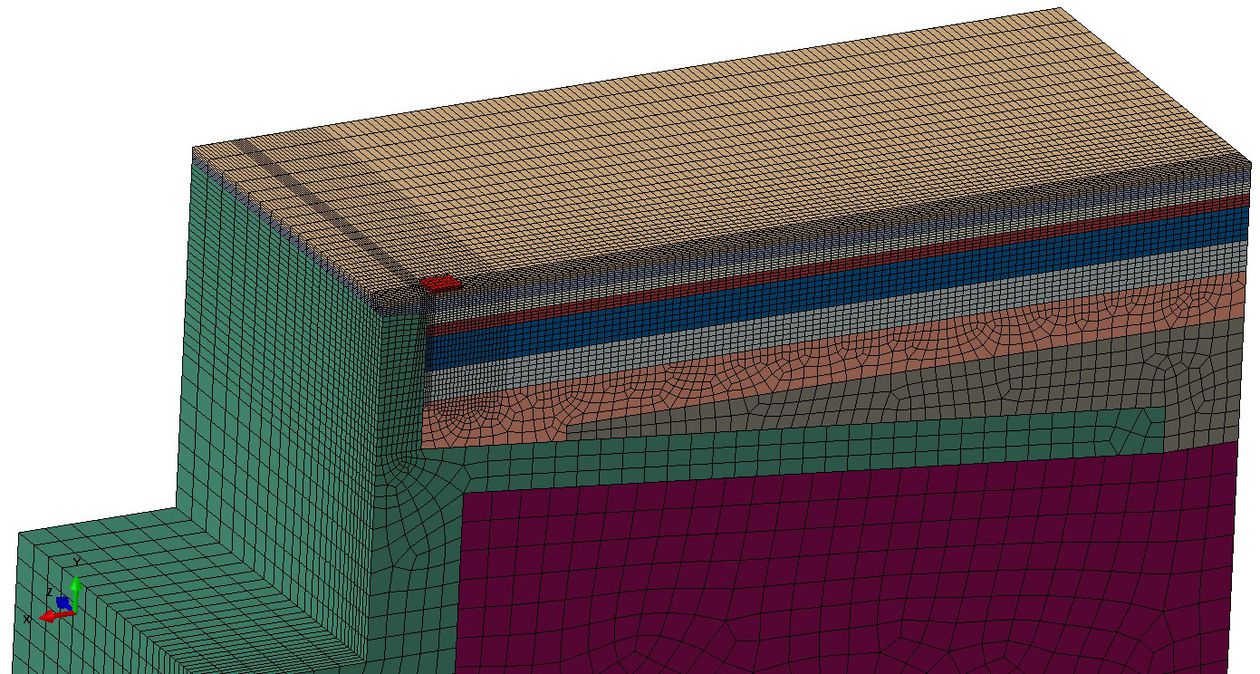Opis
Transverse cracks in the asphalt pavement were observed on bridge structures next to single-module expansion joints with a 5 meter approach slab set at the depth of 1 m. The finite element (FE) models of the approach pavement were created to investigate the reasons of premature cracking and crack initiation mechanism over the back edge of the abutment wall.
The finite element method (FEM) was used together with non-destructive test (NDT) methods: ground penetrating radar (GPR) and laser scanning technology in diagnostics of pavement transverse cracks. The anomalies observed in the in situ GPR maps indicate the occurrence of inhomogeneous compaction zones of increased humidity or air voids in bridge approach pavement. The reduced compaction of the asphalt layers was confirmed by the cylindrical cores taken directly at the bridge joint. The maximum lowering of the pavement surface by 1.7 cm was recorded by a laser scanner at a distance of 30 cm from the steel profile of the expansion device. These measurements confirmed uneven settlement of the pavement over the edge of the abutment.

The dataset contains input files with model data and output database files with results for three FE models. Longitudinal plane of symmetry, a half-wheel load of 28.75 kN and full bonding between the pavement layers were adopted in the models. More details about the models are given in the readme file and related publication.

In the first model, the deformation of approach pavement under moving load was determined in the quasi-static analysis. The analysis of maximum deflection in function of distance from the expansion joint showed that designed approach slab solution does not provide a continuous change in support stiffness for the asphalt layers. The significant difference in stiffness between the concrete wall and the pavement layers results in a rapid increase in vertical displacement behind the abutment wall.
In the second model, detailed static analysis of the stress state in the vicinity of the transverse cracks was performed for the critical position of the wheel load. The concentration of von Mises stress, transverse shear stresses and vertical tensile stresses exceeding the tensile strength were observed at the back edge of the abutment wall.
In the third model, damage of the pavement structure in stress concentration region was simulated by removing finite elements from it. This model showed that the inadequate support of the top asphalt layers, caused by reduced compaction of the asphalt layers and cracking due to stress concentration, may result in large longitudinal tensile stresses at the bottom of the binder course.
The results obtained for FE models suggested that transverse cracking was initiated directly above the back edge of the abutment wall and then propagated upward. Surface unevenness magnify the dynamic effects, so they may have contributed to fatigue cracking. The use of a specific approach in FEM makes it possible to study the crack propagation and predict the number of cycles to pavement failure in future studies.
Plik z danymi badawczymi
hexmd5(md5(part1)+md5(part2)+...)-{parts_count} gdzie pojedyncza część pliku jest wielkości 512 MBPrzykładowy skrypt do wyliczenia:
https://github.com/antespi/s3md5
Informacje szczegółowe o pliku
- Licencja:
-
otwiera się w nowej karcie
CC BYUznanie autorstwa - Dane surowe:
- Dane zawarte w datasecie nie zostały w żaden sposób przetworzone.
- Oprogramowanie:
- Output database files can be opened in Abaqus 6.14 or newer.
Informacje szczegółowe
- Rok publikacji:
- 2023
- Data zatwierdzenia:
- 2023-04-28
- Język danych badawczych:
- angielski
- DOI:
- Identyfikator DOI 10.34808/hc27-sd11 otwiera się w nowej karcie
- Weryfikacja:
- Politechnika Gdańska
Słowa kluczowe
- transverse cracks
- nondestructive diagnostics
- bridge pavement
- approach slab
- expansion joint
- finite element method
- numerical models
Powiązane zasoby
Cytuj jako
Autorzy
wyświetlono 273 razy

